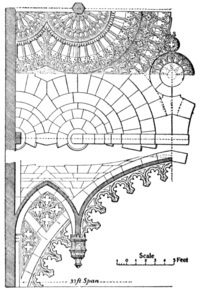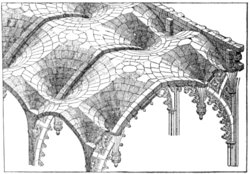and wall ribs were all worked out of one stone; and (2) the lower courses were all made horizontal, constituting what is known as the tas-de-charge (q.v.) or solid springer. Fig. 9 is a diagram made by Professor Willis taken from the south transept of Westminster Abbey. The horizontal courses rise to N. or about half the height of the vault, but the ribs are freed from one another from the point M. The tas-de-charge, or solid springer, had two advantages: (1) it enabled the stone courses to run straight through the wall, so as to bond the whole together much better; and (2) it lessened the span of the vault, which then required a centring of smaller dimensions. As soon as the ribs were completed, the web or stone; shell of the vault was laid on them. In some English work, as may be seen in fig. 9, each course of stone was of uniform height from one side to the other; but, as the diagonal rib was longer than either the transverse or wall rib, the course dipped towards the former, and at the apex of the vault were cut to fit one another. At an early

Fig. 9.—AB, springing of transverse and diagonal ribs; P, centre of the same; DE, longitudinal ridge rib; DF, intersection of webs; M, top of solid springer; KN, starting level of web; LK, springing of wall rib; EBD, bosses at intersection of ribs.
period, in consequence of the great span of the vault and the very slight rise or curvature of the web, it was thought better to simplify the construction of the web by introducing intermediate ribs between the wall rib and the diagonal rib and between the diagonal and the transverse ribs; and in order to meet the thrust of these intermediate ribs a ridge rib was required, and the prolongation of this rib to the wall rib hid the junction of the web at the summit, which Was not always very sightly, and constituted the ridge rib. In France, on the other hand, the web courses were always laid horizontally, and they are therefore of unequal height, increasing towards the diagonal rib. Each course also was given a slight rise in the centre, so as to increase its strength; this enabled the French masons to dispense with the intermediate rib, which was not introduced by them till the 15th century, and then more as a decorative than a constructive feature, as the domical form given to the French web rendered unnecessary the ridge rib, which, with some few exceptions, exists only in England. In both English and French vaulting centring was rarely required for the building of the web, a template (Fr. cerce) being employed to support the stones of each ring until it was complete. In Italy, Germany and Spain the French method of building the web was adopted, with horizontal courses and a domical form. Sometimes, in the case of comparatively narrow compartments, and more especially in clerestories, the wall rib was stilted, and this caused a peculiar twisting of the web, as may be seen in fig. 9, where te springing of the wall rib is at K: to these twisted surfaces the term "ploughshare vaulting" is given.
One of the earliest examples of the introduction of the intermediate rib is found in the nave of Lincoln Cathedral, and there the ridge rib is not carried to the wall rib. It was soon found, however, that the construction of the web was much facilitated by additional ribs, and consequently there was a tendency to increase their number, so that in the nave of Exeter Cathedral three intermediate ribs were provided between the wall rib and the diagonal rib. In order to mask the junction of the various ribs, their intersections were ornamented with richly carved bosses, and this practice increased on the introduction of another short rib, known as the lierne, a term in France given to the ridge rib. Lierne ribs in English vaults are sport ribs crossing between the main ribs, and were employed chiefly as decorative features, as, for instance, in the stellar vault (see Plate I. fig. 16), one of the best examples of which exists in the vault of the oriel window of Crosby Hall, London. The tendency to increase the number of ribs led to singular results in some cases, as in the choir of Gloucester (see Plate II. fig. 17), where the ordinary diagonal ribs become mere ornamental mouldings on the surface of an intersected pointed barrel vault, and again in the cloisters, where the introduction of the fan vault, forming a concave-sided conoid, returned to the principles of the Roman geometrical vault. This is further shown in the construction of these fan vaults, for although in the earliest examples each of the ribs above the tas-de-charge was an independent feature, eventually it was found easier to carve them and the web out of the solid stone, so that the rib and web were purely decorative and had no constructional or independent functions. The fan vault would seem to have owed its origin to the employment of centrings of one curve for all the ribs, instead of having separate centrings for the transverse, diagonal wall and intermediate ribs; it was facilitated also by the introduction of the four-centred arch, because the lower portion of the arch formed part of the fan, or conoid, and the upper part could be extended at pleasure with a greater radius across the vault. The simplest version is that found in the cloisters of Gloucester Cathedral, where the fans meet one another at the summit, so that there are only small compartments between the fans to be filled up. In later examples, as in King's College chapel, Cambridge (see Plate II. fig. 18), on account of the great dimensions of the vault, it was found necessary to introduce transverse ribs, which were required to give greater strength. Similar transverse ribs are found in Henry VII. 's chapel (see Plate II. fig. 19) and in the divinity schools at Oxford, where a new development presented itself. One of the defects of the fan vault at Gloucester is the appearance it gives of being half sunk in the wall; to remedy this, in the two buildings just quoted, the complete conoid is detached and treated as a pendant.
One of the most interesting examples of the fan vault is that over the staircase leading to the hall of Christ Church, Oxford, and here the complete conoid is displayed in its centre carried on a central column. This vault, not built until 1640, is an exceptional example of the long continuance of traditional workmanship, probably in Oxford transmitted in consequence of the late vaulting of the entrance gateways to the colleges. Fan vaulting is peculiar to England, the only example approaching it in France being the pendant of the Lady chapel at Caudebec, in Normandy, In France, Germany and Spain the multiplication of ribs in the 15th century led to decorative vaults of various kinds, but with some singular modifications. Thus in Germany, recognizing that the rib was no longer a necessary constructive feature, they cut it off abruptly, leaving a stump only; in France, on the other hand, they gave still more importance to the rib, by making it of greater depth, piercing it with tracery and hanging pendants from it, and the web became a horizontal stone paving laid on the top of these decorated vertical webs. This is the characteristic of the great Renaissance work in France and Spain; but it soon gave way to Italian influence, when the construction of vaults reverted to the geometrical surfaces of the Romans, without, however, always that economy in centring to which they had attached so much importance, and more especially in small

Fig. 10.
structures. In large vaults, where it constituted an important element in expense, the chief boast of some of the most eminent

Fig. 11.
architects has been that centring was dispensed with, as in the case of the dome at Florence, built by Brunelleschi, and Ferguson cites as an example the great dome of the church at
